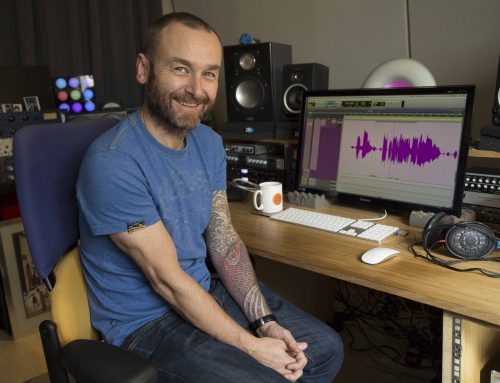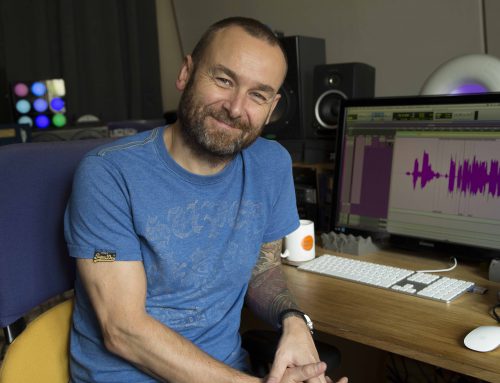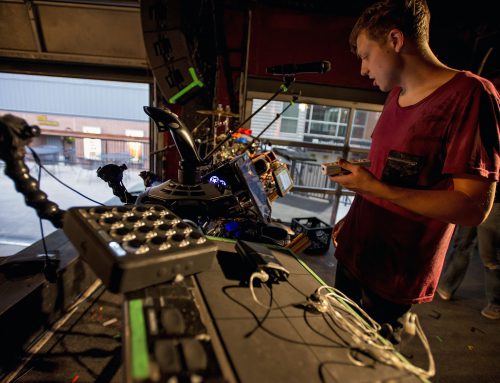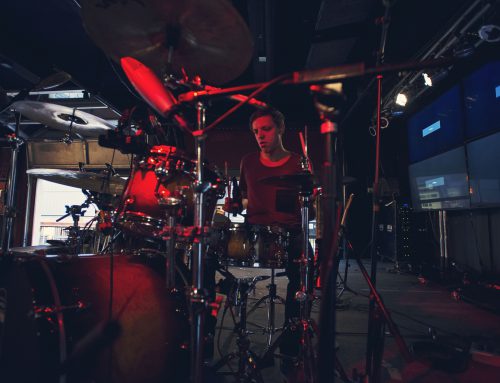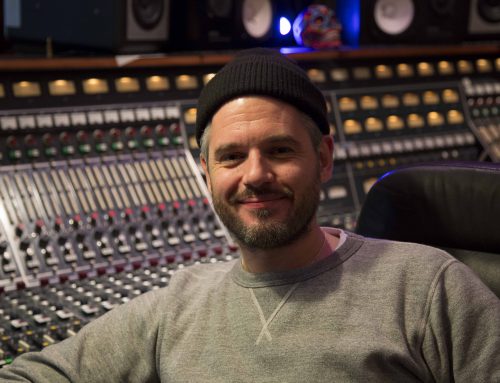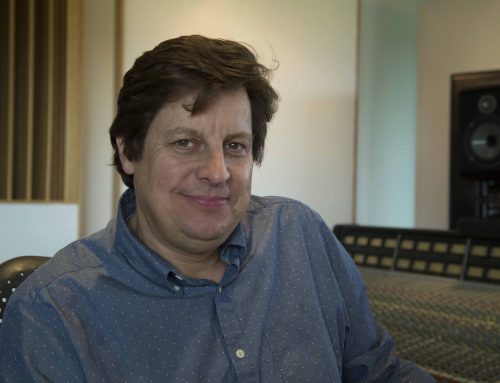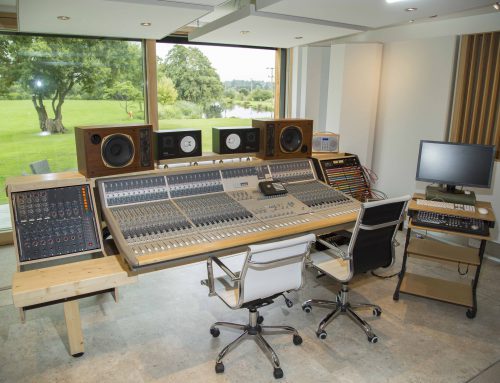Marius de Vries is one of the most respected and sought-after producers working in the industry today, earning two BAFTAs for his work as Musical Director on the ambitious film Moulin Rouge and as composer and co-producer on Romeo+Juliet, and helping Björk shape the sound of many of her albums. We take a look at his London studio and find out about his latest projects.
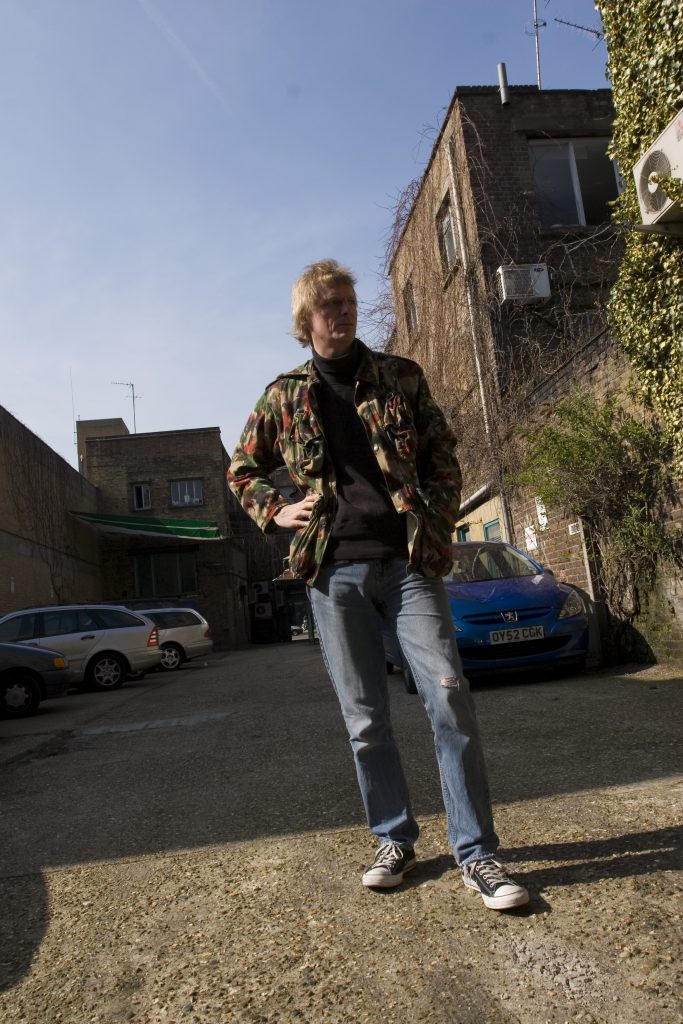
Marius de Vries outside his studio. Photo by TF
“The business of making records and distributing them, as it has been understood up to now, is over – it’s finished!” states Marius de Vries, emphatically. “No one’s buying records so the whole infrastructure upon which the record industry is based has eroded or subsided. I’m talking about Warners, Universal, BMG and Sony. Your average 18 year old, who is interested in music, is using Spotify or downloading from iTunes or various less legal alternatives. Going down to the HMV shop, as you and I would have done in our youth, was something we’d do routinely every Saturday – that’s not on the radar anymore. The music business will survive, but the record business is finished, except as a specialist, niche market for a certain kind of DJ, a certain kind of audiophile, and a certain kind of fetishistic collector who might be tempted by a particular colour of vinyl.
“On the one hand it’s a catastrophe, but on the other, it’s evolution, and we’ve got to get used to it, stop complaining, and find a way of surviving in this new world.”
Making It Pay
It seems inevitable, then, that many producers will no longer be able to make money out of records and must find other sources of income. Marius however, is continuing to produce, having recently worked on Teddy Thomson’s album A Piece of What You Need, which included the hit single ‘In My Arms’, and is currently finishing editing a new album by Chinese folk singer and songwriter Sa Ding Ding. Moving beyond record production, Marius is also in the process of developing material for Andrew Lloyd Webber’s Phantom of the Opera II musical. “That’s been a little bit of a departure, but over the years I’ve done a fair bit of musical theatre – I worked on Bombay Dreams, which was the first Bollywood musical in London, with AA Rahman. And I’ve just finished the score and soundtrack for the new Stephan Elliott movie, called Easy Virtue. It’s not a musical but has some of that adventurousness in its musical language.
“I’m going to try to keep making good music and trying to expand the variety of the platforms I work on, so it’s not just CDs and records but different media, more film and theatrical work – to keep searching for new contexts; taking lateral approaches to what music can be used for. I have faith that people will always need music in one form or another and there will always be a way of selling it to them. I’m just keeping my fingers crossed and trying to do good work in the mean time.”
For many years, Marius has based his studio at the Strongroom complex in East London, although the rooms he currently occupies have been his for about three years, having moved from an upstairs room now used by ex-Abbey Road engineer Haydn Bendall. “It’s a good community here,” insists Marius. “There’s a lot of other creative activity going on and extensive options for recording when I need bigger or different spaces. If I need more space and more microphones because there’s a string section coming in, for example, it’s just over the yard. There’s also a healthy, DVD/post/audio visual scene – so it’s just a good context, a good base. We share resources and there’s an efficient infrastructure.”
The current studio has a large reception room which doubles as a secondary programming space, within which Marius’ assistant, Jason Boshoff was working at the time of our interview. To the left of this is a much smaller area, used to store a few miscellaneous bits of gear, leading to the studio’s vocal booth and Marius’ main control room.
At the time of our last meeting, for an interview about his role as Musical director on the Baz Luhrman musical Moulin Rouge, and his production work on Bjork’s highly ambitious album Vespertine, Marius was based near Cambridge, having set up a studio in his back garden. Now back in London, having moved there for family and other reasons, some of the Cambridge studio is at least partially preserved. “I don’t really have exactly the same gear I had in Cambridge because it’s been incrementally replaced,” he admits “but the fundamental wiring from the patchbay to the desk and around the room, and the floor boxes that you can see tucked away, is all getting on for 15 or 16 years old now! It was designed to be semi-portable, with the patchbay in the rack so you can just slap the lids on the flightcases and move it.”
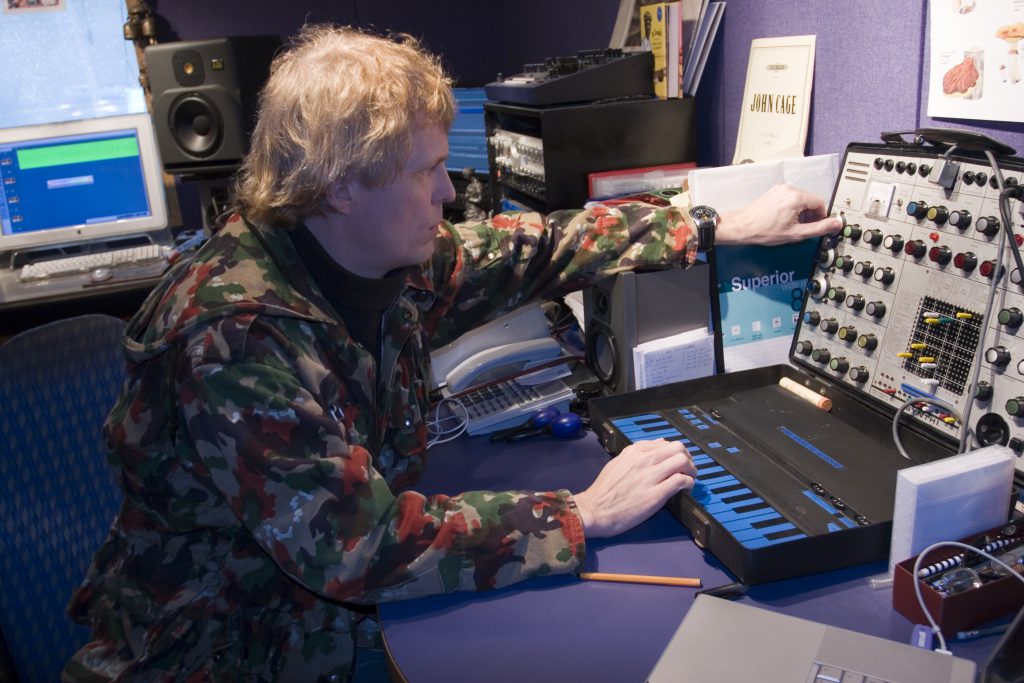
Marius on the EMS Synthi
The Old And The New
Inevitably, Maruis is using his hardware sound modules and samplers less frequently, now that more convenient, powerful and flexible software alternatives are plentiful. Old favourites, like the Roland JV1080 sound module and Akai S3200 sampler are very rarely used now. “Most of the stuff in the rack is now pretty much redundant unless there’s a specific old sound I want to get at or some other precise reason for going back to it,” he explains, “so the modules stay switched off most of the time. I do go to the MKS80 every so often. I guess that when I last spoke to you in 2001, the Akai samplers were at the heart of my system; now they are just gathering dust.
I still love to work with the real vintage stuff, and that’s a very important part of what I do. I like the Arp 2600 and the EMS Synthi very much, and the SE/Moog. The Waldorf Wave I had was Björk’s so she took it back! I got some great sounds out of it but it was a bit of a monster and not very reliable, so I wasn’t particularly tempted to spend £6000 on replacing the one I was borrowing!”
For his sampling needs, Marius tends to use Logic Audio’s EXS24 sampler for simple jobs, deferring to Native Instruments’ Kontakt when a more complicated task is being undertaken. “The Logic sampler is a mainstay for a lot of my projects – because it’s simple and it does what it says on the tin. I’d go to Logic every time for straightforward sample playback. It’s less memory intensive and quicker than Kontakt, which is, however, fantastic for more sophisticated procedures. Kontakt is a far more serious instrument in terms of sample layout and manipulation, and offers much more sophisticated filtering and processing.”
Naturally, soft synths are also very important instruments in the Strongroom studio, and one of Marius’ favourites is the esoteric Supercollider audio synthesis programming language. “I still love it!” he says. “The only good version was the OS9 one, before they made it free, and tried to port it to OSX, and I think it’s stopped being developed now, so I have an old power book running OS9 for that. I did an electro acoustic ballet for the South Bank at the beginning of last year – Squaremap of Q4, with Spanish choreographer Rafael Bonachela – and Supercollider got used a lot for that. It’s still very much a favourite instrument. It feels vintage like the ARP feels vintage, but in a different kind of way.
“It’s like any of those text-based music synthesis languages where you can make inspired numerical changes to a patch – a 4 to a 1, or multiply a number by 3 – and see what you get. People are always concerning themselves with how important it is to have a maximum amount of hands-on control over music, and that’s one very sensible and viable argument but, on the other hand, it’s quite interesting what happens when you have no control of that sort. It’s not random; it’s a mathematical, numeric sort of proportional, arithmetic way of imagining how sound might be generated, and the way that connects with the foundation of music in mathematics, on a deep level, is very interesting. People have been fascinated by the numeric side of what makes music work, from Plato onwards. The best formulation is Leibniz’s ‘Music is the mathematics of the soul.’
“There’s that great moment in Kontakte by Stockhausen where a plunging EMS sound drifts into subsonic territory and clearly demonstrates the relationship that rhythm has with frequency and pitch. At some level rhythm and frequency is the same thing. And – without oversimplifying – when you hear a harmony which is proportionate, and therefore sounds harmonious, it is because there is a mathematical relationship which is identical, or at least related, to the mathematical relationship that makes a groove work. It just exists in a different order of frequencies.
“In other words, the mathematics that makes a certain arrangement of drum hits feel right in a particular context is related to the mathematics that makes a particular chord sound good in terms of the relationship of the frequencies of the notes within that chord. They’re the same fractions, you could say. It’s one of those things you occasionally have time to stop and think about in the process of creating this stuff!”
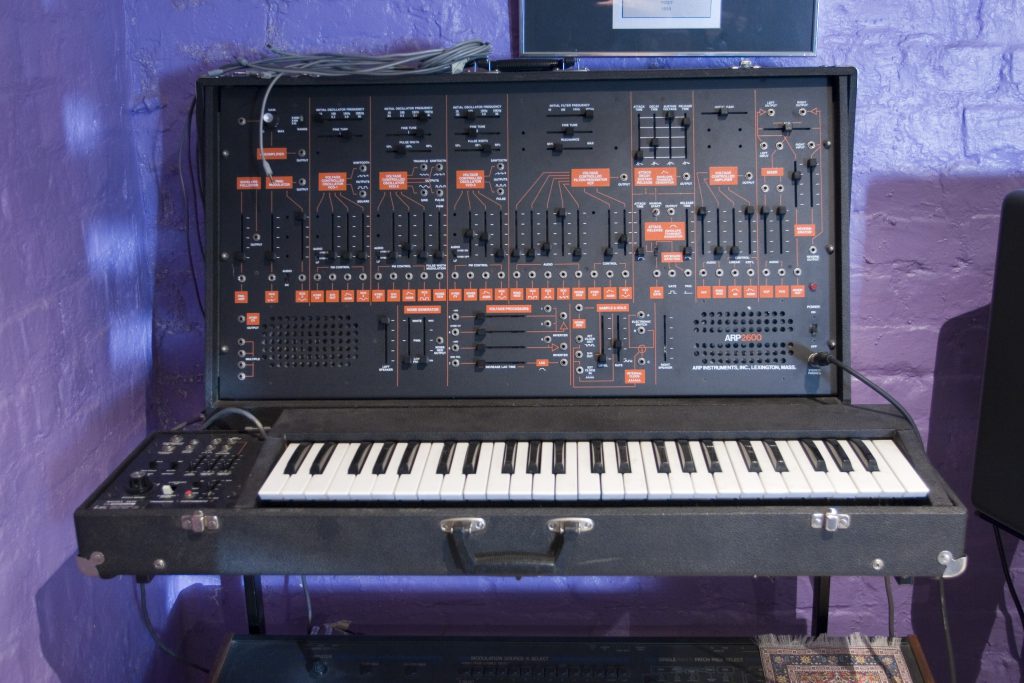
Arp 2600 synthesizer
Library Music
Hidden away on hard drive is Marius’ custom sound library, developed and refined over many years. Now that his previous assistant Alexis Smith has moved on, the job of organizing the material, editing it into useable samples and formatting it appropriately, has fallen to Jason. “Alexis has gone onto bigger things and has his own career now,” explains Marius, “although we’re still close and he’s back in the fold this year, helping out on the Sa Ding Ding album project. Jason runs a slightly parallel operation here, but he helps project-manage most of the stuff I do. One of Jason’s many talents is his organized mind: he’s a fantastic librarian. Back in the day the sounds were all on Akais, but now it has been re-categorized, re-librarianized and re-catalogued, so it’s all in AIFF format on one array of drives, which is, depending on the type of material, accessible by Logic, EXS, Kontakt or programs like Spectrasonics’ Stylus, if it is more rhythm-oriented.
“There’s a central brain which is common to all of the systems we operate even if we are working on three projects at the same time. That brain houses the sample library and an archive of all projects that have been worked on throughout history, and that’s pretty well catalogued. It’s not online in a sort of ‘mobile me’ scenario, but it is networked and is theoretically, and in most cases practically, accessible to any of our remote units we use as we’re traveling around.”
When creating sounds destined for the library, Marius tends to record directly into Logic Audio, where he can make basic edits or port the files into Kontakt. “I do lots and lots of recording very fast,” he explains. “I don’t tend to leave decision making until later, but I do leave a lot of the hard work until we are in a cheaper environment. If you are in a studio with a lot of musicians and paying £1200 a day for the room, you don’t really want to be spending a lot of time scratching your head, you want to be working fast, intuitively and efficiently.
“Some of the gathering you do is non-specific: you just say ‘That’s just a great sound, I don’t know what it is or where it belongs.’ And some of it is very specific. An example is my recent trip to China where we are making a record that has one foot in Chinese ethnology and folk music, provincial folk music, and the other foot in modern electronic recording manipulation processes. I was recording all the time, capturing everything I could find that was musical, including ambiences and atmospheres. But all of that was not necessarily with a musical line in mind, but with the intention of building up a library that would enable me to create the record out of authentic material that belongs in the place that it is supposed to be representing.
“Lots of long recordings that can happily live on the hard drive and get chopped up later because memory is cheap now and so there is no limit to how much you can store. People’s looping skills are becoming slightly redundant. That’s revolutionized the process I suppose.”
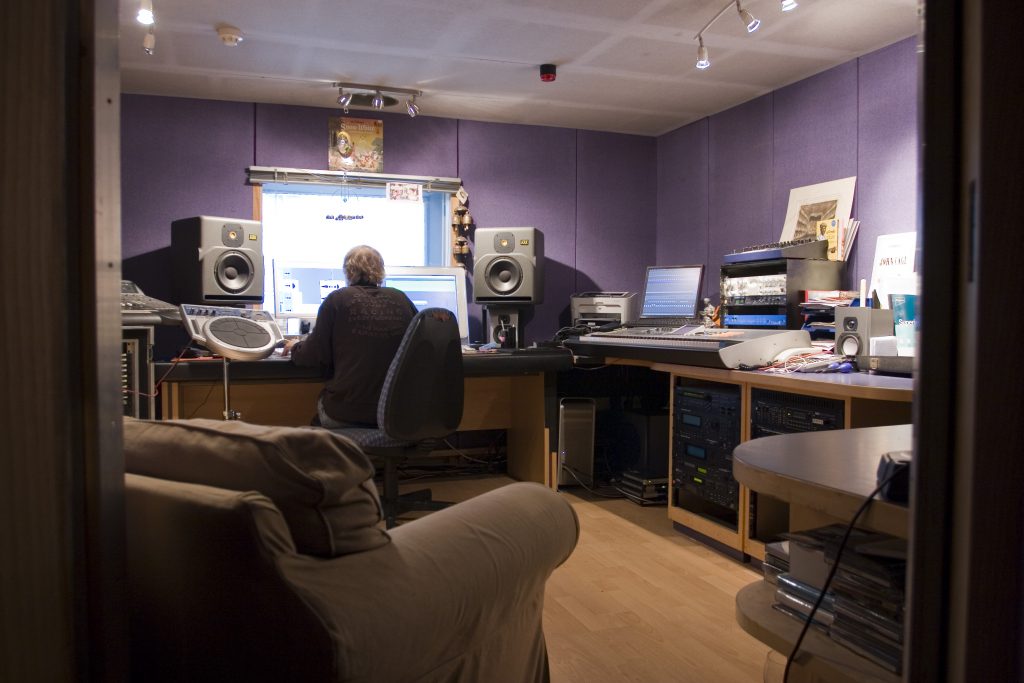
View from the doorway
Other Gear
Having launched his career in the music industry as a session keyboardist, the studio keyboard is very important to Marius. The Roland’s Fantom X8 is the instrument of choice, proving to be so favourable that he owns three of them! “It has a fantastic feel to the keyboard and the piano responds very musically. It has some great sounds onboard but, to be honest, it rarely gets used beyond the piano sound! I might under-use it, but I depend on it; it is a very comforting thing to have around. Keyboard-wise I am extremely loyal to Roland – they make the best synths and always have done.
“Most of my equipment is so standard now it is hardly worth talking about. I use Logic, although I haven’t quite made the plunge into Logic 8, which I am still finding very unfriendly as an interface, but that’s going to have to happen when they make 7 redundant. The bunch of softsynths I use are the usual suspects. I am heavily reliant on Native Instruments who have been very supportive. We have a bit of a partnership and I have everything they do and use it a lot.
“The Mackie D8B is a functional board, but I don’t do much mixing on it now. I do the first level of mixing ‘in the box’ then I might go to the studio of someone like my friend Andy Bradfield, if it needs to be finessed beyond my abilities. Even then, we don’t really use a big desk very much anymore. The last time we did an SSL mix was last year, mixing Teddy Thompson’s album. If you have the budget for it, it is still worth doing for reasons of sound quality and flexibility.
“Monitor-wise, I’m still in love with my KRKs and have the 9000Bs as studio monitors. I’ll be very sad when I can’t get a replacement pair. And a Quad 404 MkII amp which, as Mark Stent showed me, is the best thing to drive them with.
“The little Blue Sky monitors are part of a surround sound system. I’ve been doing a couple of theatrical and film music projects where we’ve been mixing in surround. They were good for getting a flavour of what it’s going to sound like, but when we were doing the big mix we got in another array of KRKs and filled the room with those.
“They are fed from the MOTU interface which comes off my second rig. Outputs 1 and 2 drive the KRKs, and the remaining outputs send to the surround array so we can just flick a switch and turn the whole mix into a surround mix.”
“The Pro Tools hardware that is plumbed in here is the old 888 system running from a G4 with as much memory in it as you can cram. That really hasn’t changed but all I use that for is recording. There’s no point in upgrading this at the moment because it is good quality, zero latency recording, and that’s all I need from it. In the other room we have a traveling system which is a Pro Tools 8, 192 HD3 setup. Manipulations and assemblies tend to happen in the second rig in my main room which has a Logic 7/Native/MOTU system on it.
“For the front end, the main suspects are the Avalon 737s mic amp and my lucky black U87 reissue that’s in the vocal booth.”
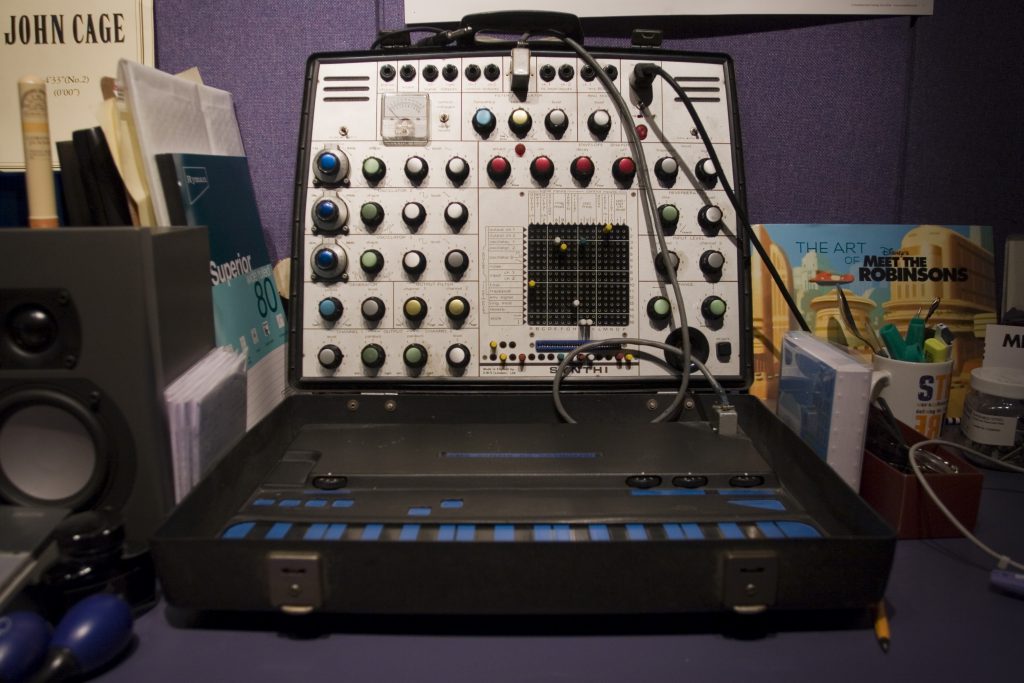
EMS Synthi
Recording Teddy Thompson
One of the most well-known album productions Marius has completed in the last year is Teddy Thompson’s A Piece of What You Need, essentially a pop record with an American country feel, making use of strings and numerous vintage keyboard instruments to supplement the singer’s strong vocals and acoustic guitar playing. “Well you can’t – you wouldn’t want to – take the country out of Teddy!” laughs Marius, explaining the project’s brief. “He was profoundly influenced by it from an early age, but the album before this one was really his country album. What was in his head was to make a pop record, but what was in my head was to sort of stop him from making just a pop record. He came along with a set of beautifully written, very focused and elegantly simple songs, and I tried to give them a context that would stop them from being too simplistically and plainly presented, or not having a sonic context that would make them interesting in terms of their arrangement and construction.
“And I guess he realized that’s what he wanted too: he needed someone to give another dimension, that was very clearly established in our first conversation, and that was why it worked so well in the end. The reason we had a great time doing it was because we were very clear about what we were trying to achieve.
“Teddy used to come in and sing back-ups on the Rufus Wainwright records I was making so we knew each other, he’d seen me work and he watched what naturally developed over the years that Rufus and I worked together. I suppose, in a way, he wanted that process to be applied to his music.”
“With a singer like Teddy you want to put his vocal up front because he’s a very expressive: he’s got that particular velvety emotive quality. It’s a great voice. Just like, Rufus Wainwright, you want people to listen to him first and foremost, and everything else fits around that.
“I don’t really have any set philosophy about EQing or panning. First of all I try to look after each sound in terms of its own requirement, then in relation to the other sounds that are there. Whatever positioning, treatment or filtering is necessary to achieve that is done instinctively.”
Budget Recording
Surprisingly, given that it has such a lush sound, the album was made without the benefit of a huge budget. “I knew it was going to have to be fast and live because we were focused quite a lot by the budget, so I got some great players together, booked a great sounding, and somewhat old-school, studio in New York called The Magic Shop, which is full of fantastic instruments. It has a great collection of old harmoniums, vibraphones, organs, percussion instruments, a tack piano, and a very characterful grand piano.
“A lot of that record’s sound is a product of where we recorded it. I wanted a studio that had a lot of stuff that you wouldn’t normally turn to necessarily, but because it was there you’d be forced, or seduced, into using it. And so the Farfisa, the Harmonium, the Vox Continental – all that stuff – that’s the sound of the record. It’s what happened to be there at the time. We used very few synths.
“Everything was set up all the time in a big, big room so anytime anyone wanted to go and play and organ solo it was there and ready to go.
“There were still tons of overdubs, but we wanted to capture takes that would be the backbone of the song and dress them up later. The sound of the room was very important because everything had its place and that informs the sound of the record as much as any mixing philosophy about panning. It was just that room, those instruments and those people.
“The room was full of microphones, all recording all the time. Some of those keyboard sounds are spill from the organ picked up through the drum mics, which just happened to sound good. You can, of course, end up painting yourself into a corner because everything is all over everything else, and that’s where you have to put your faith in the musicianship of the people who are there and also learn to cherish mistakes. There are imperfections in timing, and occasionally pitch, but because they are heartfelt and played with the right spirit, actually don’t matter at all.”
Of all Marius’ qualities as a producer, it seems that it is his ability to work in collaboration with other art forms, such as film and dance, that is likely to help him continue his career while the record business declines. Of course, having to compromise the musical vision of a piece to fit someone else’s ideas requires a diplomatic and flexible approach, which is not always comfortable. “It depends on who is saying it and whether I trust their judgment eventually,” he laughs. “Sometimes it’s painful but you have to adopt a certain attitude of humility because in those situations music isn’t in the driving seat – it’s in the business of helping tell the story and has to knuckle down and do that.”
Marius agrees that he has become quite adept at manipulating music successfully so that it satisfies the demands of choreography and film editing. “An interesting part of the challenge is working out how to do it, because the grammar of visual storytelling or theatrical storytelling and the grammar of music are not always perfectly in sync and it is the grammar of music that has to bend! But that’s really good in a fundamental way because it encourages you not to think in blocks of four and eight, which is the way we are all schooled to do from the way that technology is designed, and out of pure laziness. So many songs just don’t break that rule at all.
“For me now, I find it difficult to listen to music that’s constructed in those numbered, symmetrical block arrangements, and I spent a lot of the ’80s working in exactly that language because of the house mixes and dance mixes we were doing. The best of that kind of music has dispensed with that to a greater or lesser extent, so when I hear something with eight bars of one thing and then another eight bars where something drops out and something else comes in on top, I find it almost un-listenable.
“The Wire magazine did this thing where they sent Stockhausen various pieces of what was, at the time, very current cutting-edge electronica, to see what he thought about it. He listened to the Aphex Twin which, even to my mind, is very sophisticated, imaginative, admirably mind-bending dance music, and his significant comment was ‘He has to abandon his obsession with post-African repetition!’
It speaks to this thing I’m talking about: repetition. Obviously through this language we work with there is a certain kind of repetition which is at the heart of it and always will be, and for many people the sort of music that Stockhausen makes, where he’s entirely abandoned repetition, is incomprehensible, but he has got a point!”
The Midas Touch
Many artists and film makers looking for a music producer who can steer their project in the right direction have selected Marius de Vries for the job, either aware of his skills from seeing him work, from hearing about him by word of mouth, or having found something uniquely interesting when listening to the productions he’s worked on. But what exactly is it that has attracted the likes of U2, Madonna, Rufus Wainwright, Björk, Baz Luhrmann, Andrew Lloyd Webber, and countless others, to call upon his services? “Possibly it’s because I work well with people,” reflects Marius. “It is always very important to me to be working with people, as far as is possible, who have something to say, musically and lyrically. And it is my priority, before I do anything, to figure out what that thing is and focus the efforts of everybody who’s involved in the project to making that happen. I suppose, like anyone, I have certain stylistic ticks; but in general I don’t think I have a particular imprint that I stick onto things – because I try to subordinate everything to the vision of the project and aggressively protect that against anything that will water it down or divert it in the wrong direction.” TF
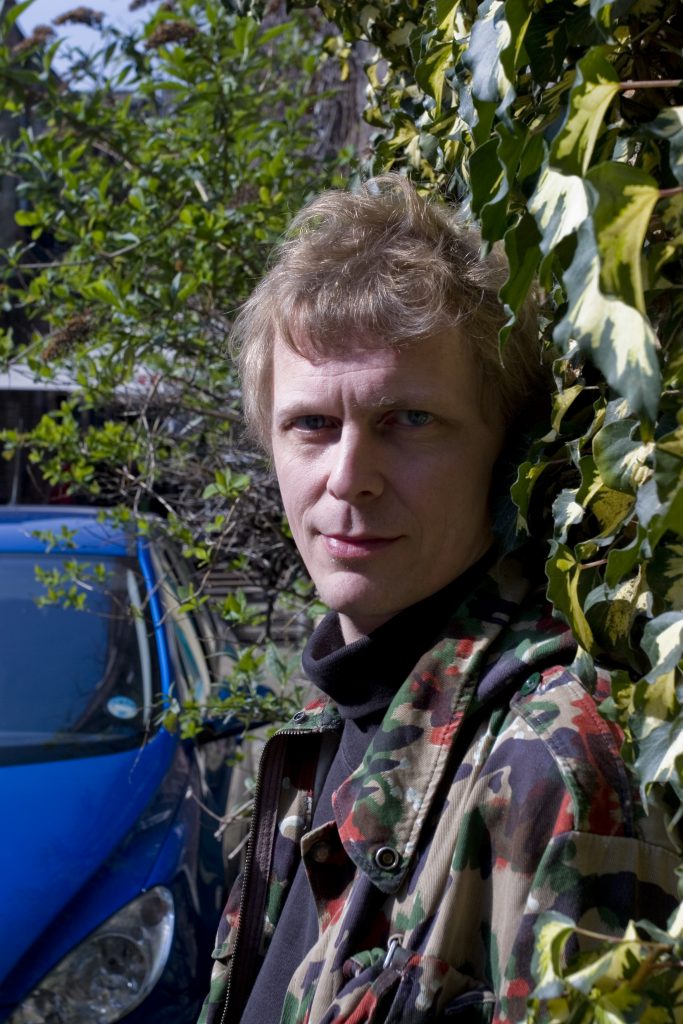
Marius blending in!

